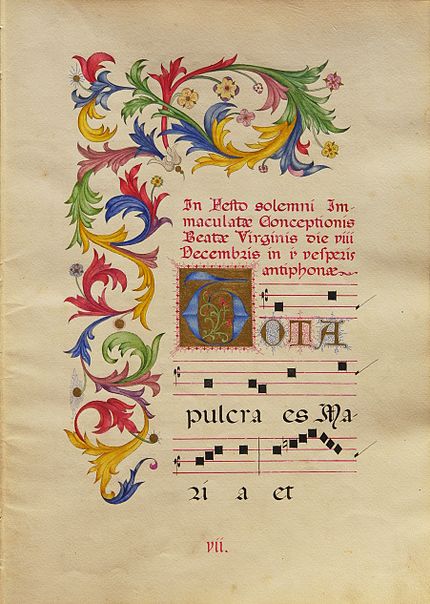Tota pulchra es
This article needs additional citations for verification. (September 2008) |
Tota pulchra es is an old Catholic prayer, written in the fourth century. It is one of the five antiphons for the psalms of Second Vespers for the Feast of the Immaculate Conception. The title means "You are completely beautiful" (referring to the Virgin Mary). It speaks of her immaculate conception. It takes some text from the book of Judith, and other text from Song of Songs, specifically 4:7.[1]
Composers to set the prayer to music include Robert Schumann, Anton Bruckner,[2] Pablo Casals, Maurice Duruflé, Guillaume du Fay,[citation needed] Grzegorz Gerwazy Gorczycki, Heinrich Isaac, James MacMillan.[3] and Ola Gjeilo.[4]
Text

Tota pulchra
Tota pulchra es, Maria.
Et macula originalis non est in Te.
Tu gloria Ierusalem.
Tu laetitia Israel.
Tu honorificentia populi nostri.
Tu advocata peccatorum.
O Maria, O Maria.
Virgo prudentissima.
Mater clementissima.
Ora pro nobis.
Intercede pro nobis.
Ad Dominum Iesum Christum.
You are all beautiful, Mary,
and the original stain [spot] (of sin) is not in you.
You are the glory of Jerusalem,
you are the joy of Israel,
you give honour to our people.
You are an advocate of sinners.
O Mary,
Virgin most intelligent,
Mother most merciful.
Pray for us,
Plead for us,
To the Lord Jesus Christ.
Music
Maurice Duruflé set the prayer in Latin as No. 2 of his Quatre Motets sur des thèmes grégoriens.
References
- ^ http://www.newadvent.org/bible/son004.htm from Old Catholic Encyclopedia
- ^ p. 33, Watson (1997) Derek. New York Bruckner Schuster & Macmillan
- ^ [1]
- ^ [2]
External links
- Tota pulchra es - Maian hymn (with Gregorian square notation). Youtube (in Latin). Archived from the original on March 16, 2018.
